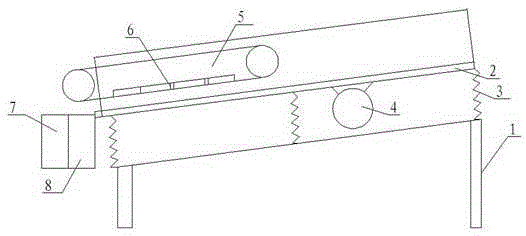Vibration type magnetic separator for mine
A vibratory and magnetic separator technology, applied in magnetic separation, chemical instruments and methods, solid separation, etc., can solve the problems of low recovery rate and low grade of concentrate
- Summary
- Abstract
- Description
- Claims
- Application Information
AI Technical Summary
Problems solved by technology
Method used
Image
Examples
Embodiment 1
[0037] Such as figure 1 As shown, the vibrating magnetic separator for mines of the present invention includes a frame 1, and the frame 1 is provided with a vibrating plate 2 arranged obliquely, and the vibrating plate 2 is arranged inclined at 30°-45°, preferably Arranged at an angle of 43°, the vibrating plate 2 is arranged on the frame 1 through the vibrating spring 3, and the bottom surface of the vibrating plate 2 is provided with a vibrator 4; above the lower end of the vibrating plate 2, a magnetic separator is provided. Equipment 5, the end of the vibration plate 2 is provided with a non-magnetic ore port 7 and a magnetic ore port 8, wherein the magnetic ore port 8 is aligned with the ore throwing place of the magnetic separation equipment 5. Wherein said magnetic separation device 5 comprises a pair of rollers, a conveyor belt and a magnetic system 6, said conveyor belt is driven around the pair of rollers, said transmission belt is relatively parallel to the highest ...
Embodiment 2
[0050] This embodiment is the same as Embodiment 1, except that the components of the non-magnetic stainless steel of the vibration plate 2 are calculated by weight percentage (the following % all represent weight percentages): carbon is 0.15%, nickel is 5%, Chromium is 8%, manganese is 8%, silicon is 4%, niobium is 0.65%, vanadium is 0.47%, molybdenum is 1.2%, titanium is 3%, rare earth is 0.33%, and the total amount of phosphorus and sulfur does not exceed 0.035%. The balance is iron and its unavoidable impurities.
[0051] Above-mentioned non-magnetic stainless steel is made through the following steps:
[0052] Step 1. Use an intermediate frequency induction furnace for melting, put the raw iron into the converter for heating and melting, after the raw iron is completely melted, adjust the temperature of the molten pool so that the temperature of the molten pool is controlled at about 1550°C, and then add a decarburizer into the molten pool , desulfurizer, deoxidizer, dec...
Embodiment 3
[0062] This embodiment is the same as Embodiments 1 and 2, except that the components of the non-magnetic stainless steel of the vibrating plate 2 are calculated by weight percentage (the following % all represent weight percentages): carbon is 0.21%, nickel is 3 %, chromium is 13%, manganese is 11%, silicon is 5%, niobium is 0.48%, vanadium is 0.13%, molybdenum is 1.7%, titanium is 4%, rare earth is 0.27%, and the total amount of phosphorus and sulfur does not exceed 0.035 %, the balance is iron and its unavoidable impurities.
[0063] The preparation method of above-mentioned nonmagnetic stainless steel comprises the following steps:
[0064] Step 1. Use an intermediate frequency induction furnace for melting, put the raw iron into the converter for heating and melting, after the raw iron is completely melted, adjust the temperature of the molten pool so that the temperature of the molten pool is controlled at about 1550°C, and then add a decarburizer into the molten pool ,...
PUM
| Property | Measurement | Unit |
|---|---|---|
| thickness | aaaaa | aaaaa |
| thickness | aaaaa | aaaaa |
Abstract
Description
Claims
Application Information
 Login to View More
Login to View More - R&D
- Intellectual Property
- Life Sciences
- Materials
- Tech Scout
- Unparalleled Data Quality
- Higher Quality Content
- 60% Fewer Hallucinations
Browse by: Latest US Patents, China's latest patents, Technical Efficacy Thesaurus, Application Domain, Technology Topic, Popular Technical Reports.
© 2025 PatSnap. All rights reserved.Legal|Privacy policy|Modern Slavery Act Transparency Statement|Sitemap|About US| Contact US: help@patsnap.com


